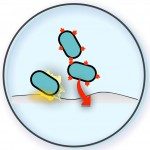Link to Pubmed [PMID] – 16585767
J. Bacteriol. 2006 Apr;188(8):3073-87
Bacterial growth on a surface often involves the production of a polysaccharide-rich extracellular matrix that provides structural support for the formation of biofilm communities. In Salmonella, cellulose is one of the major constituents of the biofilm matrix. Its production is regulated by CsgD and the diguanylate cyclase AdrA that activates cellulose synthesis at a posttranscriptional level. Here, we studied a collection of Escherichia coli isolates, and we found that the ability to produce cellulose is a common trait shared by more than 50% of the tested strains. We investigated the genetic determinants of cellulose production and its role in biofilm formation in the commensal strain E. coli 1094. By contrast with the Salmonella cellulose regulatory cascade, neither CsgD nor AdrA is required in E. coli 1094 to regulate cellulose production. In this strain, an alternative cellulose regulatory pathway is used, which involves the GGDEF domain protein, YedQ. Although AdrA(1094) is functional, it is weakly expressed in E. coli 1094 compared to YedQ, which constitutively activates cellulose production under all tested environmental conditions. The study of cellulose regulation in several other E. coli isolates showed that, besides the CsgD/AdrA regulatory pathway, both CsgD-independent/YedQ-dependent and CsgD-independent/YedQ-independent pathways are found, indicating that alternative cellulose pathways are common in E. coli and possibly in other cellulose-producing Enterobacteriaceae.


